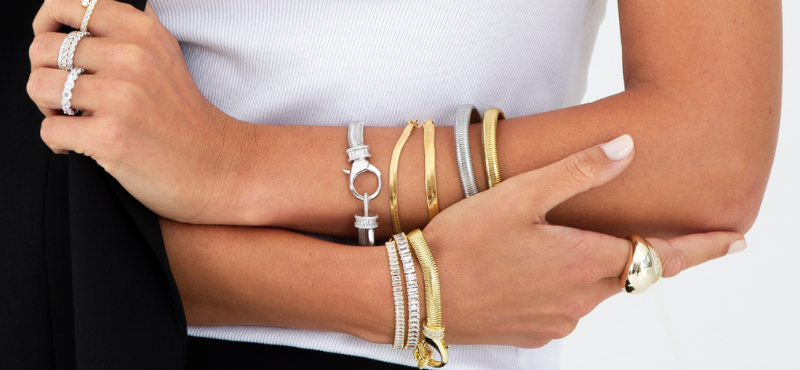Lab grown diamonds are taking over the diamond market, creating a sustainable and ethically sourced alternative to natural diamonds. Before we tell you how these diamonds are disrupting the market, let's get a better understanding of the lab grown diamond.
What Are Lab Grown Diamonds?
Lab grown, also known as synthetic or cultured diamonds, are diamonds created in a controlled laboratory environment rather than being mined from the earth. They possess the same chemical composition, crystal structure, optical, and physical properties as natural diamonds.
What’s The Difference Between The Different Diamonds?
While both diamond types are very similar looking to the naked eye, making it hard for someone to spot the difference, the main differences are in how the diamonds are made and their value.
How Are Lab Grown Diamonds Made?
They are created using two primary methods: High Pressure High Temperature (HPHT) and Chemical Vapor Deposition (CVD). In HPHT, carbon is subjected to high pressure and temperature to form a diamond crystal. In CVD, a diamond seed is placed in a chamber filled with carbon-rich gas, and the carbon atoms accumulate on the seed, gradually forming a diamond.
How Are Lab Grown Diamonds More Ethical?
These diamonds are often considered more ethical for several reasons: They do not involve environmentally damaging mining practices. They do not contribute to issues such as forced labor or conflict diamonds, which can be associated with traditional diamond mining. They have a transparent supply chain, allowing consumers to trace the origin of the diamond more easily.
Are Lab Grown Diamonds Cheaper Than Natural Diamonds?
As there are many factors that go into determining the cost of a diamond, statistically lab grown can be 60% - 80% less in price than the natural diamond that contains the same values. So yes, lab grown is less expensive than natural diamonds due to their abundance, but it comes down to the values of the diamond to determine the price.
Will Lab Grown Diamonds Hold Their Value?
The value may fluctuate over time, much like natural diamonds. However, it's important to note that lab grown typically cost less than natural diamonds of comparable quality. As technology advances and the market for alternative diamonds grows, their value may stabilize or even increase. However, it's advisable to consult with experts in the field for specific insights into the long-term value prospects for all diamond types.
How Do I Take Care Of Lab Grown Diamonds?
You should store and clean them just the same as how you would for natural diamonds. If you are not comfortable cleaning your diamonds on your own, consider taking them to a professional to guarantee a long lasting shine.
What Are The 4 C’s Of Diamonds?
The four c’s of diamonds value are color, cut, clarity and carat weight. These four factors are what makes one diamond more expensive than the other and it's what appraisers use to scale the value of a diamond on. Let’s make you an expert on these characteristics, so you feel the most prepared the next time you are buying diamonds.
COLOR: When it comes to diamond color there is a scale from D to Z. D being colorless and Z being a color presence in the stone. All of Adina Eden’s lab grown diamonds are the color G.
CUT: A diamond’s cut refers to the different facets that create and reflect sparkle in your stone. Adina Eden’s lab grown diamonds come in many different cuts.
CLARITY: A diamond's clarity is weighed on a scale that measures the inclusions or blemishes a diamond has. Adina Eden’s lab grown diamonds are all a VS1 on the clarity scale.
CARAT: When you are looking for engagement rings you’ll frequently hear about carats, but what do they mean? A diamond carat size is just the weight of the stone. You can find many of our lab grown diamonds in a variety of carat sizes to cater to all price points! Adina Eden’s carat sizes range from 0.25CT up to 2CT.
What Shapes Do Lab Grown Diamonds Come In?
Our many styles come in an array of different shapes. The shapes include: round, oval, cushion, princess, and emerald. Not only do we carry a regular prong set diamond, we also carry bezel set styles. Unsure what the difference is, here you go: In a bezel setting, the diamond is more protected in a thicker casing of gold, while in a prong setting, the diamond is more exposed only secured by a few prongs. Take a look at the rest of our collection that includes stud earrings, necklaces, eternity bands, and engagement rings!
Why Do People Buy Lab Grown Diamonds?
Now that we have covered all the basics, let's answer your biggest question, what makes people interested in lab grown diamonds? In our opinion there are two main reasons why people want to buy this type of diamond. The first being that it's a great alternative to the same look as a natural diamond but for a more reasonable price. The second reason why people are interested, especially for engagement rings, is that they can serve as a great travel ring if you do not want to risk something happening to your natural diamond ring during your travels.
How Lab Grown Diamonds Are Disrupting The Diamond Industry?
Natural diamonds have a following of individuals who seek value and rarity in their jewelry, especially one of a kind pieces. Now, with this type of consumer, it is much smaller group of people than the greater consumer of the rest of the world. With this being said, lab grown offers a more budget friendly and ethically sourced product that appeals to that greater base of people that may not be able to afford natural diamonds but want the same look. Besides the price, the fact that lab grown is sustainable and ethically sourced is a huge win for those in the space. Younger generations such as gen Z are prioritizing sustainability more than ever and they make up around 35% of consumers in the US. Given that they shop with sustainability as a top priority and are most likely on a budget, this gives lab grown a hand up for years to come! Learn even more about these beautiful diamonds and check out the collection today!

















